#lighting design
Explore tagged Tumblr posts
Text
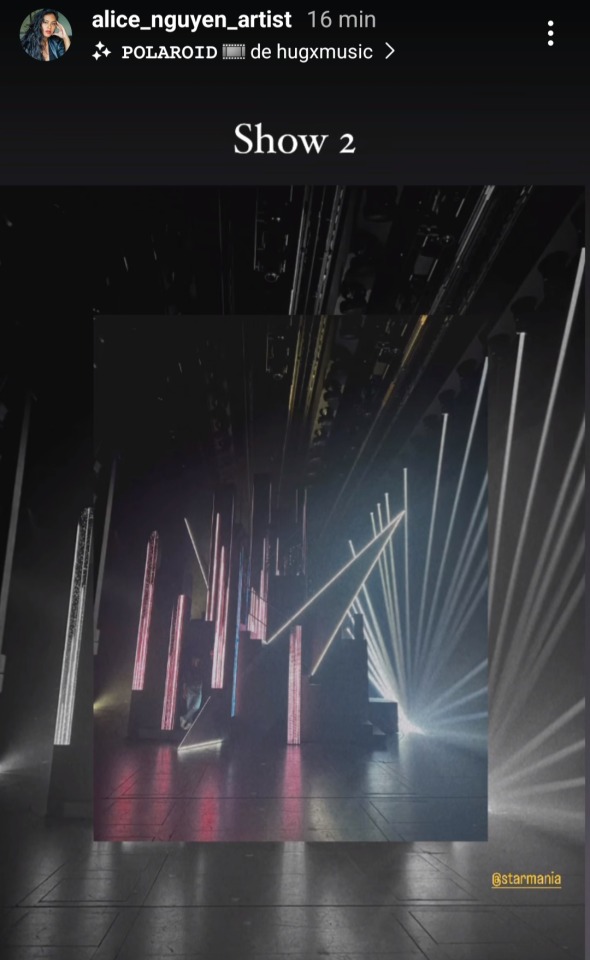
Monopolis from the wings, Aug 7, 2024
#starmania 2022#season 2#starmania on tour#sets & costumes#lighting design#starmania in quebec#from the wings
4 notes
·
View notes
Text
Truth right there!
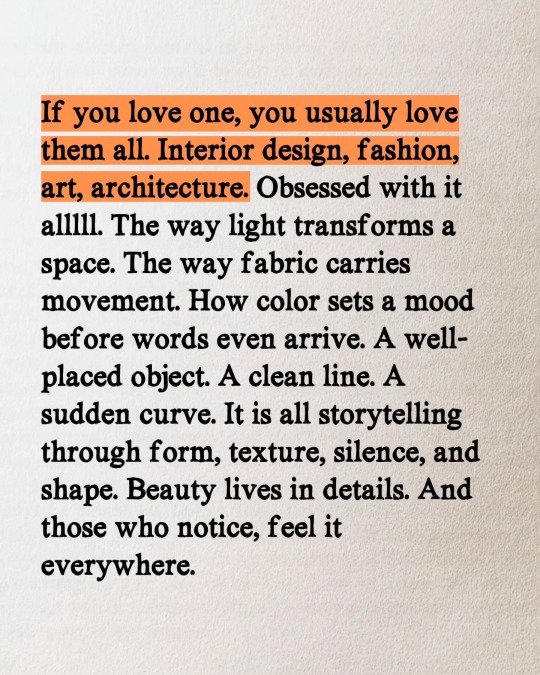
134 notes
·
View notes
Text

Wood & Glass Lamp by Shawn Michael Lucas
#wood lamp#glass lamp#stained glass lamp#stained glass#decorate#home decor#interior decorating#home decorating#decor#lighting design#light#lamp#home#toya's tales#toyastales#toyas tales#style#art#interior design#summer#july
9K notes
·
View notes
Photo

Artistic Bird-Shaped Canopy Bed Follow Research.Lighting on Tumblr
#vintage#midcentury#retro#modern#design#product design#home#decor#decoration#home decor#home design#interiors#interior design#living room#bedroom#kitchen#buildings#architecture#furniture#furniture design#industrial design#minimalism#minimal#living rooms#lighting design#lights#bathroom#contemporary
10K notes
·
View notes
Text
Get your best side this #AniMonday
We really wanted a hand drawn feel for the Nimona movie, so one of my first tasks was to hand draw three Ballister light tests. One two tone test, one three tone test, and a third with a dithered effect.
Sculpt by Vicki Saulls
#nimona#Ballister#ballister boldheart#ballister blackheart#cartoon#animation#lighting#lighting design#blue sky studios#tvpaint
2K notes
·
View notes
Photo

Moon Aligns with Observatory Dome Follow Souda on Tumblr
#Inspiration#Inspiring#dream#surreal#modern#design#product design#home#decor#decoration#home decor#home design#interiors#interior design#living room#bedroom#kitchen#buildings#architecture#furniture#furniture design#industrial design#minimalism#minimal#living rooms#lighting design#lights#bathroom
5K notes
·
View notes
Text

#lightroom#lighting design#lights#escaleras#home decor#interior design#garder#garden terrace#gardening#interiors#inspiration#decor#bathroom#scenery#home & lifestyle#floral#flowers
851 notes
·
View notes
Text

1K notes
·
View notes
Text
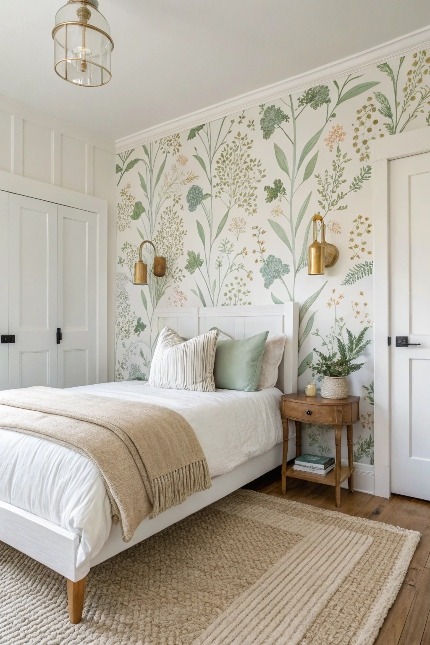
#home decor#interior design#interiors#decor#inspiration#bathroom#scenery#floral#flowers#home & lifestyle#lighting design
534 notes
·
View notes
Text
Gabias and Lighting Design
I graduate with my BA in theatre in a few weeks and this is apparently how I'm using my new degree. But I am so so normal about how the lighting in Tobias' dances reflects his relationship with creation
In Piece 1, the main color scheme is just dark, blue and moody. You can barely make out any individual dancer and they all blend into one larger, moving body. All of the dancers are stuck in isolated spotlights and lit only by profile lights - the lights on the sides of the stage. This casts dramatic shadows over everyone's faces, so despite them dancing together, they can barely see each other. Tobias is lacking personal connection to the people around him, and his inspiration isn't clear yet.
The opposite happens in Off Rhythm, where the dancers are overexposed in a cool wash lights on a white set, making everything just brutally intense. Tobias is trying to make sense of too many things at once, in this sudden shift of his career and relationships. While the people around him understand his vision, to anyone on the outside (e.g., the critics), it looks disjointed and chaotic.
Piece 2 starts like Piece 1, still very blue but with a bit more clarity this time.
But in Whatever This Is, everything is much more complimentary and clear. Specifically, it revolves around Gabin, both his presence on stage and the development of their relationship. We get the most variety in this piece, especially in color lighting the cyclorama (the white sheet hanging at the back of the stage). Pink for budding feelings, purple for uncertainty, blue for sorrow, and yellow/orange for love. At the beginning of the number, when Gabin begins, the lights are pink, edging out a dreary gray, before rotating through purple and blue, as Tobias and Gabin struggled to maintain a healthy relationship in their first few weeks together. When Gabin leaves briefly, the lights transition to purple, then a deep blue. Over the men specifically, like in Piece 1, deep blue wash lights completely envelope the male dancers, making them virtually indistinguishable from each other. Tobias is still struggling over the reviews of his last piece and losing his étoile. Nothing is working, and he’s more depressed than we’ve ever seen him. But when Gabin returns (both to the stage and to Tobias’ life), the overhead wash lights gradually shift back into more flattering, joyful colors. The wash lights are brighter and warmer, bringing out the life in the dancers, not just the dance. Pink and purple start to push the blue out of the cyc lights, reflecting Gabin and Tobias' healing relationship. When Gabin is finally alone for the end of the song, the lights are peachy yellow, as they move past the ways they've hurt each other into a stronger connection. As if to put the nail in the coffin, right before Tobias takes the stage to kiss Gabin, there's a final pop of fiery orange, overtaking the last moment of doubtful blue. Tobias was always a great choreographer, but Gabin is what truly inspired him and reignited his love for creating.
Honestly, the real hero of Whatever This Is is the stage manager and/or lighting designer who managed to busk through the entire new number.
#DON'T EVEN GET ME STARTED ON THE TRANSLATION OF THE SONG IN 108#graduating with honors and this is how I use that experience#I’m probably reading way too far into this#sorry if this sounds insane it’s because I am insane#gabias#tobias x gabin#tobias bell#gabin roux#etoile#étoile#lighting design#text post
258 notes
·
View notes
Text
Ok no, we have to talk about the lighting design this season. Like I need to physically get this out of my body before I implode.
Because it’s so deliberate. It's obnoxiously deliberate. In the best, most beautiful, emotionally manipulative way.
So. Let’s talk about Belinda’s bedroom scene.
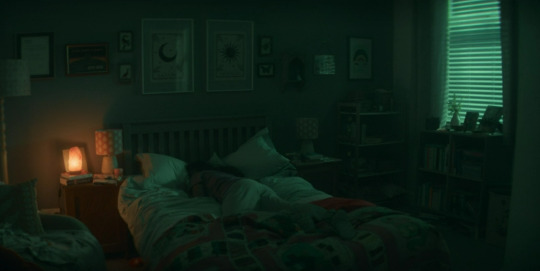
We open on Belinda’s bedroom, and the first thing you notice is that it’s drenched—absolutely soaked—in a cool teal-green wash. Not a trace of warmth in the room’s ambient light (aside from the salt lamp but I'll get to it).
Teal is a weirdly loaded color. People always slap it on when they want “serenity” or “calm,” sure, but there’s something haunting about the way it’s used here. It doesn’t feel like peace—it feels like the kind of stillness that happens after something ends. Like the quiet after the noise. That post-shift haze where your body’s in bed but your brain hasn’t followed yet.
What this tells us about Belinda? She’s stuck. The teal isn’t soothing her—it’s holding her in place. This isn’t a woman “relaxing” after work. This is a woman numbed by routine. She’s lying on top of the covers in a basic t-shirt, sweatpants, and socks—clothes that aren’t chosen, just defaulted to. The bed isn’t made. The room isn’t messy, but it isn’t cared for either. It's just… there. Like her.
Everything feels low-energy, lived-in without being truly inhabited. There’s a faint sense of order, but it doesn’t feel owned. There’s no vitality in the space. Like she’s present, but not alive. Teal here isn’t calm—it’s domestic sedation. It’s the color of pause. Of liminality.

Then there's that salt lamp. This soft, orange-yellow glow tucked in the corner of the frame. Warm, comforting, alive—completely opposite the teal-blue void it’s fighting against. It’s the only light source in the room that feels personal. Human.
And it’s not just that it’s a warm color. Color emotion theory tells us that orange and amber tones evoke feelings of warmth, optimism, and emotional openness. They're often used to simulate firelight, tapping into a primal sense of security—think hearth, sunset, candle. These hues are associated with creativity and personal connection. In a sea of teal, which promotes detachment, this little pocket of orange is like a flare of identity. A soul-spark.
Where teal sedates, amber invites. It’s the color of possibility, of life that hasn’t been extinguished yet. It's why the lamp doesn't light the room—it gives it a pulse.
Now here’s the kicker: the salt lamp is right under the star placard. The one with her name on it. The one that kickstarts the entire plot because a whole alien race thinks it makes her their queen.
The lamp’s glow reads like a tiny heartbeat in an otherwise frozen space. Symbolically, it’s the spark of self. That little ember of hope, joy, personality, belief—whatever you want to call it—that hasn’t been drowned out by the monotony of her life yet.
And the fact that it's under the placard? It's literally illuminating the part of her that the universe is about to claim.

Next we cut to a close-up of Belinda in bed. The composition here is brilliant.
Her pillow and the surrounding sheets are washed in the same cool teal light we saw earlier—but her? She's glowing in the orange warmth of the salt lamp.
This isn’t just pretty lighting—it’s duality. It's saying, “Here’s who she is now” (the teal), “and here’s what’s still inside her” (the glow). There’s a literal split happening—like she’s caught in a transition she doesn’t realize is coming.
This is the in-between. Her liminal moment. She’s not where she was, and she’s not yet where she’s going. But the camera lingers like it knows. Like it’s waiting for the change to start.

Then—boom. The lighting shifts. We get this violently bright, harsh yellow light flooding in through the window. And it doesn’t just pour in—it slices in. Through the blinds. In bars.
Let me say that again: bars.
It’s casting shadows across her body like a prison cell. That’s not an accident. It’s signaling that something is coming for her, and it’s not asking permission. It’s claiming her.
Yellow is a deceptive color in emotional theory. People think of it as cheerful—sunlight, sunflowers, warmth, joy, energy. But in design, especially in lighting? Yellow walks a tightrope. It can tilt into chaos fast. Especially when it’s this bright. This sudden. This aggressive.
See, yellow stimulates. It grabs your attention. It speeds up the heart. In advertising, it's used to spark urgency, even irritation (think hazard lights or warning signs). It’s a color that demands you look—and keep looking. You can’t relax in yellow. You can’t sleep in yellow. You react to yellow.
So when this high-saturation yellow floods Belinda’s room, it’s not joy. It’s not hope. It’s alarm. It’s a psychological jolt. A visual shove. It's not warmth—it's pressure.
Yellow in this scene is not an invitation to a new beginning—it’s an intrusion of expectation. A sudden spotlight. A cosmic glare.
And because it’s coming from outside the room, it’s not something she’s chosen. It’s not internal. It’s a force of narrative crashing through her private life. A story she didn’t ask to be in, demanding her attention. That yellow isn’t her destiny—it’s the noise of everyone else's expectations about who she’s going to become.
Now add the shadows of the blinds—those harsh horizontal slats—and you get a visual contradiction: a color that screams freedom, cast like a cage.
This is where it gets interesting. Because yellow is also associated with identity. Think ego, confidence, clarity of purpose. But when it’s forced, when it’s too loud, too fast, too bright—it becomes performance. The expectation to be seen. To shine. To embody something.
And that’s what’s happening here. The light doesn’t just want to see her—it wants her to become something. Bigger. Brighter. More.
This yellow doesn’t light her path. It exposes her.
She’s no longer safe in teal limbo. No longer comforted by the amber pulse of her salt lamp. She’s on display now. A body in a frame, spotlighted by a universe with no context. A woman seen through blinds—literally and metaphorically—by beings who will misread everything about her.
It’s the color of being watched. Of being presumed important. Of being chosen for reasons that have nothing to do with who you actually are.
And that’s the genius of it. That yellow glow isn't warmth—it’s the burn of recognition without understanding. It’s what happens when the world thinks you’re a lightbulb and plugs you into a searchlight.
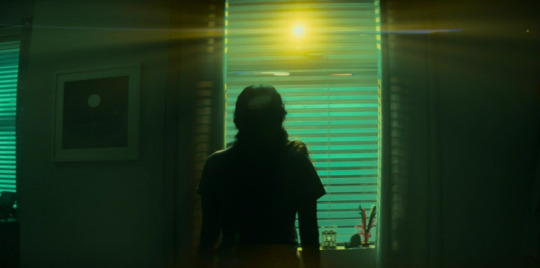
Next: the silhouette.
We see Belinda standing in front of the window, her body blacked out by the light in front of her. The yellow glows around her like a solar flare through the clouds. It’s angelic. Messianic. Looks like the birth of a chosen one.
But that’s not what’s happening.
She’s not rising to the occasion. She’s staring out, stunned, trying to make sense of what just punched its way into her night. The light frames her like a heroine, but narratively, she’s still playing catch-up. That contrast—the visual myth vs. her actual confusion—is where the scene gets its emotional punch.
We’re watching her image transform before she does. The world sees her one way. The camera frames her that way. But she hasn’t caught up to that version of herself yet.
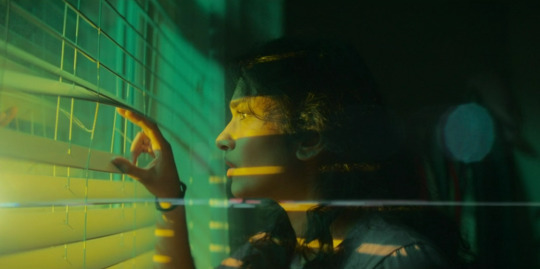
And then: the blinds.
Belinda slowly peels two slats open. A single bar of that same aggressive yellow light slices across her face and eyes. It’s dramatic. Cinematic. Looks like a revelation moment.
But it’s not a choice.
This isn’t Belinda stepping into anything. She’s not crossing a threshold. She’s just cracking the blinds because something is already happening to her—and she doesn’t understand it yet.
The light doesn’t represent clarity or destiny. It’s not a warm invitation. It’s an impact. A collision. A blunt force of something larger than her life forcing its way into her space. The yellow glow across her eyes doesn’t illuminate—it disrupts.
And that’s the real tension: she’s about to feel chosen. About to be miscast as important. But right now? She’s just tired. Just a woman in a basic tee and sweats, lying on top of the covers, poking through the blinds because something weird is happening to her, not for her. She’s not looking for meaning. She’s bracing for answers she didn’t ask to get.
That narrow beam of light slicing into the room isolates her. It spotlights her against her will. The world beyond those blinds has noticed her, and that attention is about to upend everything.
It’s the start of a misunderstanding. The beginning of being seen wrong. Of being dragged into something monumental because of one stupid star certificate and a moment she didn’t choose.
The light doesn’t welcome her. It claims her.
And the brilliance of this scene is how it tells us all of that—who Belinda is, what she’s lacking, and what’s coming—without a single word. The color palette sets her emotional baseline; the lighting builds the lie. It misleads us just enough that we feel the shift with her.
#thank you for coming to my ted talk#You guys liked the sound design thing#so I thought I'd do a positive one on the lighting design#I think next I'll do one about that underground bunker scene#because so much is happening there color wise#I swear if people say “it's not that deep” it literally is#that's what color theory and lighting design is about#belinda chandra#15th doctor#fifteenth doctor#doctor who#doctor who spoilers#dw spoilers#spoilers#doctorwho#the doctor#dw s2 e1#Doctor Who spoilers#s2 e1#Doctor Who: The Robot Revolution#Nu Who#NuWho#Doctor Who#lighting design#💡lighting design#polarity posts
204 notes
·
View notes
Text


Trip hazard
#architecture#design#interior design#lighting design#onepluspartnership#china#hotel#lobby#cinema#terracotta#earth#star wars#texture#pattern#ambience#environment
154 notes
·
View notes
Text

Lotus Lamp
#the white lotus#lotus#lamp#lamps#nightstand#bedroom decor#home aesthetic#home and garden#toya's tales#style#toyastales#toyas tales#home decor#art#interior design#march#lighting design#light#mood lighting#flower#floral#home decorating#redecorating#home & lifestyle#home design#home improvement#home#interior decorating#home interior#interiorstyling
1K notes
·
View notes
Photo

a room for play via brentabuck Follow Research.Lighting on Tumblr
#modern#design#product design#home#decor#decoration#home decor#home design#interiors#interior design#living room#bedroom#kitchen#buildings#architecture#furniture#furniture design#industrial design#minimalism#minimal#living rooms#lighting design#lights#bathroom
307 notes
·
View notes
Text
In e8, when Pen announces that she’s Lady Whistledown the lighting causes her dress to shift from green to blue.


#writing#polin#bridgerton#romance novels#late night writing#romance writers#bridgerton netflix#writer#romance#screenwriting#polin crack#bridgerton costumes#costume drama#colin x penelope#colin penelope#costume design#lighting design#movie making#movie magic#bridgerton spoilers#bridgerton season three#bridgerton s3
295 notes
·
View notes